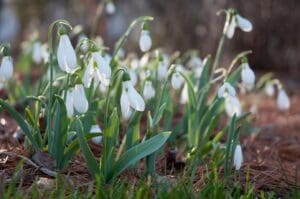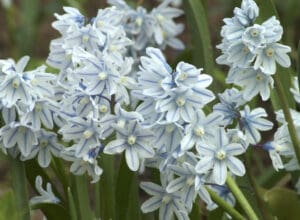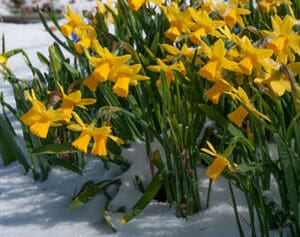Why Add Flowering Bulbs to Your Northern Virginia Garden Design
Four reasons to add early spring-flowering bulbs to your garden design are:
- Low maintenance. Bulbs are self-sustaining and do not need irrigation.
- Deer proof. (except for tulips)
- Frost resistant. Some bulbs will push right up through the snow.
- Early season color. Brightens a bare landscape.

Surrounds landscape designer Margaret Miley says an easy way to introduce bulbs into your garden design is to inter-plant them with perennials. Early spring bulbs push up in March and April, then go dormant by May. The summer perennials pick up after that, blooming from June through September.
Where to Plant Your Spring Flowering Bulbs
Many early spring flowering bulbs produce small plants that are low to the ground. So they are best viewed and enjoyed close up. Miley suggests placing plants near where you walk every day: at entryways, around mailboxes, along borders, and around the base of trees.
Many early blooming bulbs are perennial and reproduce readily. In fact, they tend to take over an area. Periodically, you have to divide the clumps of bulbs and give them more room because when they get too dense they don’t bloom as fully.
These early spring blooming bulbs spend most of their life cycle in dormancy. They come up early, bloom early and go dormant early. They store up all the light energy they need for the year in that brief period when they are above ground. If they don’t get enough light, they won’t bloom as well the next season.
Flowering Bulbs That Do Well in Northern Virginia
 The plants we recommend are all hearty bulbs and can be left in the ground over winter.
The plants we recommend are all hearty bulbs and can be left in the ground over winter.
Snow Drops. Classic and beautiful, Snow Drops are one of the earliest spring arrivals. They emerge in mid-March and grow to about six inches high.
 Striped Squill. Also called Scilia. This bulb produces a ground cover that looks like a carpet of tiny stars. They are similar to the type of flowers that grow on a forest floor. Squill is a great companion plant with perennials because it covers bare ground until the perennials fill in. In addition to white & blue striped, Squill comes in solid white and blue.
Striped Squill. Also called Scilia. This bulb produces a ground cover that looks like a carpet of tiny stars. They are similar to the type of flowers that grow on a forest floor. Squill is a great companion plant with perennials because it covers bare ground until the perennials fill in. In addition to white & blue striped, Squill comes in solid white and blue.
 Wolfsbane. This tiny yellow flower arrives even earlier than Snow Drops and Squill. Often Wolfsbane emerges in the snow. It’s a bright, happy little plant that spreads densely in a woodland environment. It has cup-shaped flowers that sit barely two inches off the ground. Plant them around the base of deciduous trees.
Wolfsbane. This tiny yellow flower arrives even earlier than Snow Drops and Squill. Often Wolfsbane emerges in the snow. It’s a bright, happy little plant that spreads densely in a woodland environment. It has cup-shaped flowers that sit barely two inches off the ground. Plant them around the base of deciduous trees.

Thalia Daffodil. Not your typical daffodil, Thalia is a white daffodil that resembles an orchid. It displays a small trumpet and long petals that flow backward. It blooms late March around the time Forsythia shrubs bloom. They stand 12-14 inches tall.
 Tete-a-Tete Daffodil. There are fifty different types of daffodils. One we like to use is a dwarf daffodil called a “Tete a Tete.” These are better able to withstand wind or a heavy rain where a taller daffodil might get knocked down. It displays up to three yellow flowers per stem. Tete-a-Tete groupings can be used to introduce a pop of color along a walkway.
Tete-a-Tete Daffodil. There are fifty different types of daffodils. One we like to use is a dwarf daffodil called a “Tete a Tete.” These are better able to withstand wind or a heavy rain where a taller daffodil might get knocked down. It displays up to three yellow flowers per stem. Tete-a-Tete groupings can be used to introduce a pop of color along a walkway.
 Allium. This is a very showy plant. Allium is sometimes called Ornamental Onion because it is part of the same family as chive, shallot, and garlic. They are very spare and minimalist looking. If you put them in with perennials, they will rise up like giant globes coming out of the bed. This bulb is a late bloomer and the last of the spring-flowering bulbs. Depending on the variety, they will show up in early May and be gone by June. Deer avoid them due to their oniony fragrance.
Allium. This is a very showy plant. Allium is sometimes called Ornamental Onion because it is part of the same family as chive, shallot, and garlic. They are very spare and minimalist looking. If you put them in with perennials, they will rise up like giant globes coming out of the bed. This bulb is a late bloomer and the last of the spring-flowering bulbs. Depending on the variety, they will show up in early May and be gone by June. Deer avoid them due to their oniony fragrance.
When to Plant Your Spring Flowering Bulbs
The end of October through November is the time to plant. The bulbs like cool, moist soil. Once planted, they quickly sprout roots and settle in for the winter. As soil temperatures rise in the spring, the bulbs start to push.
 Bulb plants are able to tolerate temperatures down to 20 degrees. Freezing temperatures will slow their growth, not stop it. These hardy plants have the ability to prevent their cells from freezing. Tender plants are vulnerable to frost because the water in their cells freezes.
Bulb plants are able to tolerate temperatures down to 20 degrees. Freezing temperatures will slow their growth, not stop it. These hardy plants have the ability to prevent their cells from freezing. Tender plants are vulnerable to frost because the water in their cells freezes.
Unlock the full potential of your lawn and gardens!
What’s the difference between a conventional landscape company and one whose staff understands design, horticulture, and landscape systems? To find out, click the button below.
If the planting is done well in the fall, you get an amazing show in the spring when most of the landscape is still dead looking or just starting to wake up. It’ll just blow your socks off.” Christian Curless, ColorBlends
 So bulbs don’t mind cold. Their enemy, says horticulturalist Christian Curless of ColorBlends, is heat. If it gets too warm, the flowers don’t last because the warmer it is, the faster they grow and complete their bloom cycle. The ideal spring weather for bulbs, Curless says, is one where the temperatures stay below 70 degrees. “When the weather stays cool, the bulbs grow but don’t race to bloom”.
So bulbs don’t mind cold. Their enemy, says horticulturalist Christian Curless of ColorBlends, is heat. If it gets too warm, the flowers don’t last because the warmer it is, the faster they grow and complete their bloom cycle. The ideal spring weather for bulbs, Curless says, is one where the temperatures stay below 70 degrees. “When the weather stays cool, the bulbs grow but don’t race to bloom”.
By adding bulbs to your garden design plan, you can achieve a continuous wave of blooms that leads up to your full summer array. Also, you can eliminate early-season bare spots in your perennial beds: As bulb foliage comes to end, the perennials will grow up, fill out and cover the area when bulbs go dormant.
If you’d like to see more color in your garden earlier in the growing season, schedule a consultation with one of our garden management specialists. We’ll help you select the right plant stock for the conditions on your property.
Perhaps you are wondering how to bring out the fullest expression in your landscape and gardens. Our eBook: Choosing the Right Kind of Landscape Maintenance Firm, is full of valuable information to help you understand the fundamental differences between landscape maintenance companies.